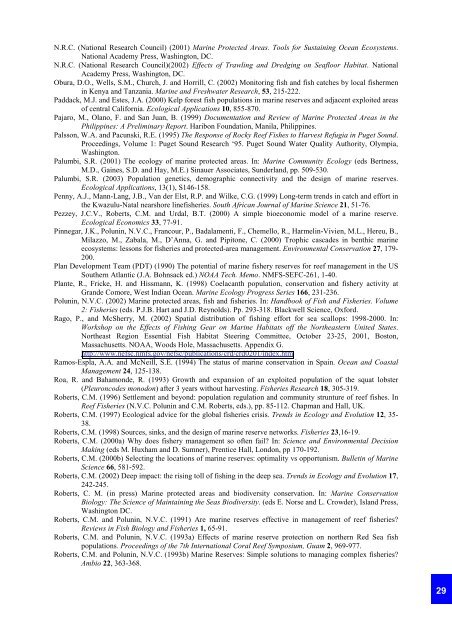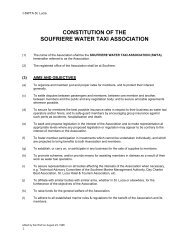Levine, A. (2002) Global partnerships in Tanzania’s marine resource management: NGOs, the private sector,and local communities. Paper submitted to the 9 th Biennial Conference of the International <strong>Association</strong>for the Study of Common Property (IASCP), Victoria Falls, Zimbabwe.Lewis, C.V.W., Lynch, D.R., Fogarty, M.J. and Mountain, D. (2001) Effects of area closures on Georges Bankbivalves: larval transport and population dynamics. http://wwwnml.dartmouth.edu/Publications/internal_reports/NML-00-2/.For simlation model, see:http://www.seascallop.com/currents.htmlLindholm, J.B., Auster, P.J., Kaufman, L.S. (1999) Habitat-mediated survivorship of juvenile (0-year) Atlanticcod Gadhus morhua. <strong>Marine</strong> Ecology Progress Series 180, 247-255.Lipcius, R.N., Stockhausen, W. T. & Eggleston, D.B. (2001a) <strong>Marine</strong> reserves for Caribbean spiny lobster:empirical evaluation and theoretical metapopulation recruitment dynamics. <strong>Marine</strong> and FreshwaterResearch, 52: 1589-1598.Lipcius, R.N., Seitz, R.D., Goldsborough, W.J., Montane, M.M. and Stockhausen, W.T. (2001b) A deepwaterdispersal corridor for adult female blue crabs in Chesapeake Bay. Spatial Process and <strong>Management</strong> of<strong>Marine</strong> Populations. Alaska Sea Grant College Program, AKK-SG-01-02, pp. 643-666.Lizaso, J.L.S., Goñi, R., Reñones, O., Charton, G., Galzin, R., Bayle, J.T., Jerez, P.S., Ruzafa, A.P., Ramos,A.A. (2000) Density dependence in marine protected populations: A review. EnvironmentalConservation 27, 144-158.Longhurst, A. (1998) Cod: perhaps if we all stood back a bit? Fisheries Research 38, 101-108.Malleret-King, D. (2000) A food security approach to marine protected area impacts on surrounding fishingcommunities: the case of the Kisite <strong>Marine</strong> National Park in Kenya. PhD Thesis, University ofWarwick, UK.<strong>Marine</strong> Reserves Task Group (MRTG) (1997) Towards a new policy on marine protected areas for South Africa.South African Network for Coastal and Oceanic Research Occasional Report 2.Maypa, A.P., Russ, G.R., Alcala, A.C. and Calumpong, H.P. (2002) Long-term trends in yield and catch rates ofthe coral reef fishery at Apo Island, Central Philippines. <strong>Marine</strong> and Freshwater Research 53, 207-213.McClanahan, T.R. and Kaunda-Arara, B. (1996) Fishery recovery in a coral reef marine park and its effects onthe adjacent fishery. Conservation Biology 10, 1187-1199.McClanahan, T.R. and Mangi, S. (2000) Spillover of exploitable fishes from a marine park and its effect on theadjacent fishery. Ecological Applications 10, 1792-1805.McClanahan, T.R. and Mangi, S. (2001) The effect of a closed area and beach seine exclusion on coral reef fishcatches. Fisheries <strong>Management</strong> and Ecology 8, 107-121.Meyer, J.L., Schultz, E.T., Helfman, G.S. (1983) Fish Schools – an asset to corals. Science 220, 1047-1049.Mosquera, I., Côté, I.M. Jennings, S. & Reynolds, J.D. 2000. Conservation benefits of marine reserves for fishpopulations. Animal Conservation 4, 321-332.Munro, J.L. (2000) Outmigration and movement of tagged coral reef fish in a marine fishery reserve in Jamaica.Proceedings of the Gulf and Caribbean Fisheries Institute 51, 557-568.Murawski, S.A., Brown, R., Lai, H.-L. Rago, P.J. and Hendrickson, L. (2000) Large-scale closed areas as afisheries management tool in temperate marine systems: the Georges Bank experience. Bulletin of<strong>Marine</strong> Science 66, 775-798.Murray, S.N., Ambrose, R.F., Bohnsack, J.A., Botsford, L.W., Carr, M.H., Davis, G.E., Dayton, P.K., Gotshall,D., Gunderson, D.R., Hixon, M.A., Lubchenco, J., Mangel, M., MacCall, A., McArdle, D.A., Ogden,J.C., Roughgarden, J., Starr, R.M., Tegner, M.J. and Yoklavich, M.M. (1999) No-take reservenetworks: sustaining fishery populations and marine ecosystems. Fisheries 24, 11-25.Murray, S.N. (1998) Effectiveness of marine life refuges on Southern California Shores. In: California and theWorld Ocean ’97. Taking a look at California’s Ocean Resources: an agenda for the future (eds. O.T.Magoon, H. Converse, B. Baird and M. Miller-Henson) American Society of Civil Engineers, Reston,VA. pp. 1453-1465.Murray, T.J. & Associates (2001) Socio-economic Baseline Development Florida Keys National <strong>Marine</strong>Sanctuary: 1998-2000.Nance, J.M., Garfield, N.H. and Paredes, J.A. (1994) Studying the social impact of the Texas shrimp closure.Human Organization 53, 88-92.NEFSC (Northeast Fisheries Science Center) (2001) Assessment of 19 Northeast Groundfish Stocks through2000. A Report to the New England Fishery <strong>Management</strong> Council’s Multi-Species MonitoringCommittee. Northeast Fisheries Science Center Reference Document 01-20.http://www.nefsc.noaa.gov/nefsc/publications/crd/crd0120/Neis, B. (1995) Fishers’ ecological knowledge and marine protected areas. In: <strong>Marine</strong> protected areas andsustainable fisheries (eds N.L. Shackell and J.H.M. Willison). Science and <strong>Management</strong> of ProtectedAreas <strong>Association</strong>, Wolfville, Nova Scotia.N.R.C. (National Research Council). (1999) Sustaining <strong>Marine</strong> Fisheries. National Academy Press, Washington,DC.28
N.R.C. (National Research Council) (2001) <strong>Marine</strong> Protected Areas. Tools for Sustaining Ocean Ecosystems.National Academy Press, Washington, DC.N.R.C. (National Research Council)(2002) Effects of Trawling and Dredging on Seafloor Habitat. NationalAcademy Press, Washington, DC.Obura, D.O., Wells, S.M., Church, J. and Horrill, C. (2002) Monitoring fish and fish catches by local fishermenin Kenya and Tanzania. <strong>Marine</strong> and Freshwater Research, 53, 215-222.Paddack, M.J. and Estes, J.A. (2000) Kelp forest fish populations in marine reserves and adjacent exploited areasof central California. Ecological Applications 10, 855-870.Pajaro, M., Olano, F. and San Juan, B. (1999) Documentation and Review of <strong>Marine</strong> Protected Areas in thePhilippines: A Preliminary Report. Haribon Foundation, Manila, Philippines.Palsson, W.A. and Pacunski, R.E. (1995) The Response of Rocky Reef Fishes to Harvest Refugia in Puget Sound.Proceedings, Volume 1: Puget Sound Research ‘95. Puget Sound Water Quality Authority, Olympia,Washington.Palumbi, S.R. (2001) The ecology of marine protected areas. In: <strong>Marine</strong> Community Ecology (eds Bertness,M.D., Gaines, S.D. and Hay, M.E.) Sinauer Associates, Sunderland, pp. 509-530.Palumbi, S.R. (2003) Population genetics, demographic connectivity and the design of marine reserves.Ecological Applications, 13(1), S146-158.Penny, A.J., Mann-Lang, J.B., Van der Elst, R.P. and Wilke, C.G. (1999) Long-term trends in catch and effort inthe Kwazulu-Natal nearshore linefisheries. South African Journal of <strong>Marine</strong> Science 21, 51-76.Pezzey, J.C.V., Roberts, C.M. and Urdal, B.T. (2000) A simple bioeconomic model of a marine reserve.Ecological Economics 33, 77-91.Pinnegar, J.K., Polunin, N.V.C., Francour, P., Badalamenti, F., Chemello, R., Harmelin-Vivien, M.L., Hereu, B.,Milazzo, M., Zabala, M., D’Anna, G. and Pipitone, C. (2000) Trophic cascades in benthic marineecosystems: lessons for fisheries and protected-area management. Environmental Conservation 27, 179-200.Plan Development Team (PDT) (1990) The potential of marine fishery reserves for reef management in the USSouthern Atlantic (J.A. Bohnsack ed.) NOAA Tech. Memo. NMFS-SEFC-261, 1-40.Plante, R., Fricke, H. and Hissmann, K. (1998) Coelacanth population, conservation and fishery activity atGrande Comore, West Indian Ocean. <strong>Marine</strong> Ecology Progress Series 166, 231-236.Polunin, N.V.C. (2002) <strong>Marine</strong> protected areas, fish and fisheries. In: Handbook of Fish and Fisheries. Volume2: Fisheries (eds. P.J.B. Hart and J.D. Reynolds). Pp. 293-318. Blackwell Science, Oxford.Rago, P., and McSherry, M. (2002) Spatial distribution of fishing effort for sea scallops: 1998-2000. In:Workshop on the Effects of Fishing Gear on <strong>Marine</strong> Habitats off the Northeastern United States.Northeast Region Essential Fish Habitat Steering Committee, October 23-25, 2001, Boston,Massachusetts. NOAA, Woods Hole, Massachusetts. Appendix G.http://www.nefsc.nmfs.gov/nefsc/publications/crd/crd0201/index.htmRamos-Espla, A.A. and McNeill, S.E. (1994) The status of marine conservation in Spain. Ocean and Coastal<strong>Management</strong> 24, 125-138.Roa, R. and Bahamonde, R. (1993) Growth and expansion of an exploited population of the squat lobster(Pleuroncodes monodon) after 3 years without harvesting. Fisheries Research 18, 305-319.Roberts, C.M. (1996) Settlement and beyond: population regulation and community strunture of reef fishes. InReef Fisheries (N.V.C. Polunin and C.M. Roberts, eds.), pp. 85-112. Chapman and Hall, UK.Roberts, C.M. (1997) Ecological advice for the global fisheries crisis. Trends in Ecology and Evolution 12, 35-38.Roberts, C.M. (1998) Sources, sinks, and the design of marine reserve networks. Fisheries 23,16-19.Roberts, C.M. (2000a) Why does fishery management so often fail? In: Science and Environmental DecisionMaking (eds M. Huxham and D. Sumner), Prentice Hall, London, pp 170-192.Roberts, C.M. (2000b) Selecting the locations of marine reserves: optimality vs opportunism. Bulletin of <strong>Marine</strong>Science 66, 581-592.Roberts, C.M. (2002) Deep impact: the rising toll of fishing in the deep sea. Trends in Ecology and Evolution 17,242-245.Roberts, C. M. (in press) <strong>Marine</strong> protected areas and biodiversity conservation. In: <strong>Marine</strong> ConservationBiology: The Science of Maintaining the Seas Biodiversity. (eds E. Norse and L. Crowder), Island Press,Washington DC.Roberts, C.M. and Polunin, N.V.C. (1991) Are marine reserves effective in management of reef fisheries?Reviews in Fish Biology and Fisheries 1, 65-91.Roberts, C.M. and Polunin, N.V.C. (1993a) Effects of marine reserve protection on northern Red Sea fishpopulations. Proceedings of the 7th International Coral Reef Symposium, Guam 2, 969-977.Roberts, C.M. and Polunin, N.V.C. (1993b) <strong>Marine</strong> Reserves: Simple solutions to managing complex fisheries?Ambio 22, 363-368.29
- Page 1 and 2: The fishery effects ofmarine reserv
- Page 3 and 4: ContentsPart 1: Review1. Summary 62
- Page 5 and 6: Part 1: Review5
- Page 7 and 8: egan being published. Those studies
- Page 9 and 10: unprotected area (21.2cm vs 38.1cm)
- Page 11 and 12: species of snappers and grouper are
- Page 13 and 14: 6.1 What are the mechanisms involve
- Page 15: They concluded that reserves coveri
- Page 18 and 19: which there are decadal shifts in e
- Page 20 and 21: managed with reserves alone, while
- Page 22 and 23: However, in some areas fishers have
- Page 24 and 25: Literature citedAlder, J. (1996) Co
- Page 26 and 27: Fiske, S.J. (1992) Sociocultural as
- Page 30 and 31: Roberts, C.M. and Hawkins, J.P. (20
- Page 32 and 33: Part 2: Case Studies32
- Page 34 and 35: Mean abundance of fish per count100
- Page 36 and 37: 2. Contrasting experiences from the
- Page 38 and 39: Russ and Alcala (1996) assessed cha
- Page 40 and 41: Key points• Very high reef fisher
- Page 42 and 43: 3. The effects of New Zealand marin
- Page 44 and 45: important species for recreational
- Page 46 and 47: Ballantine, W.J. (1991) Marine rese
- Page 48 and 49: experimental data obtained in the T
- Page 50 and 51: ReferencesAttwood, C.G. and Bennett
- Page 52 and 53: 5. Lobster fisheries management in
- Page 54 and 55: Rowe, S. and Feltham, G. (2000) Eas
- Page 56 and 57: fishers. At a meeting of fishers an
- Page 58 and 59: 7. Marine parks and other protected
- Page 60 and 61: 8. Community-based closed areas in
- Page 62 and 63: People are also seeing some species
- Page 64 and 65: 9. The Sambos Ecological Reserve, F
- Page 66 and 67: 10. The Nosy Atafana Marine Park, n
- Page 68 and 69: 11. Mombasa and Kisite Marine Parks
- Page 70 and 71: species that are mobile enough to d
- Page 72 and 73: Emerton and Tessema (2001) looked a
- Page 74 and 75: McClanahan, T.R. and Mangi, S. (200
- Page 76 and 77: Goodridge et al. (1997) collected b
- Page 78 and 79:
offshore fishing with tourism, such
- Page 80 and 81:
• The SMMA would have been improv
- Page 82 and 83:
species decreased in the second fou
- Page 84 and 85:
eserve in the form of increased cat
- Page 86 and 87:
15. Merritt Island National Wildlif
- Page 88 and 89:
Thousand Islands, St Lucie canal an
- Page 90:
is closed to scallop fishing. Ten y



